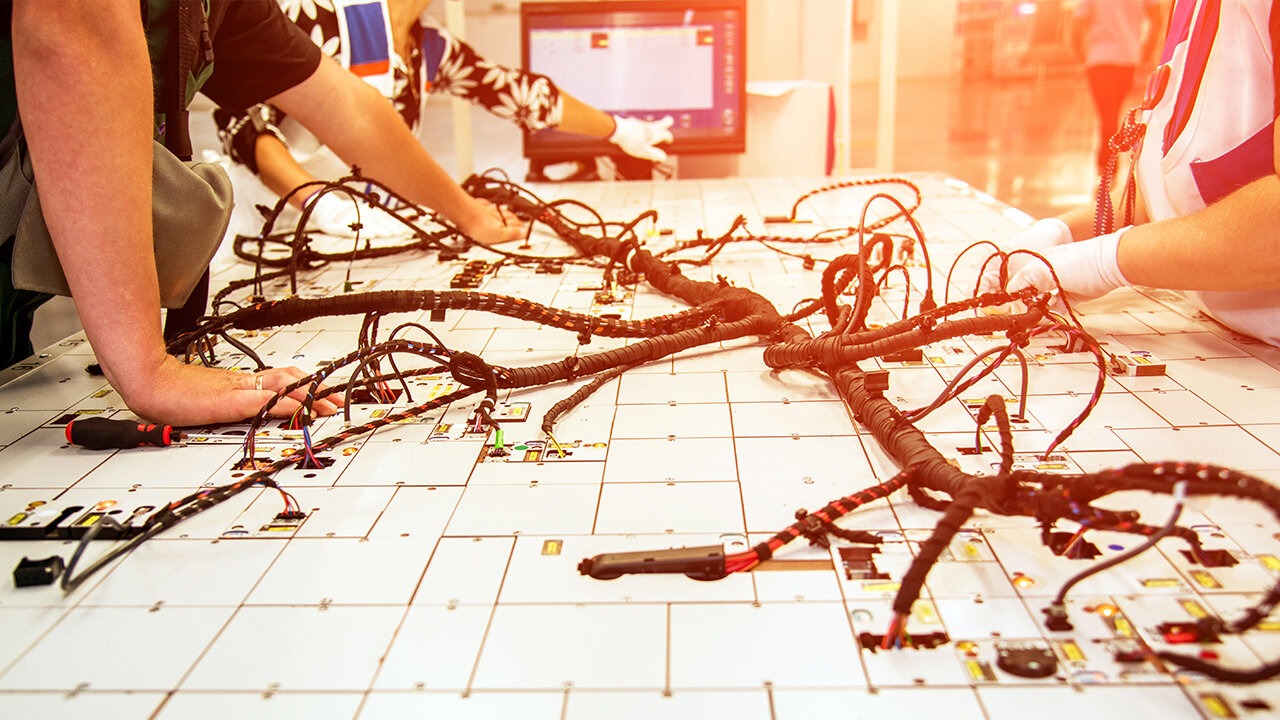
Welcome to our blog post on wire harness designs! Whether you’re an electrical engineer, a manufacturing expert, or simply curious about the world of cables and connectors, this article is for you. We’ll be delving into the basics of wire harness designs, exploring their importance in various industries, and providing valuable tips and insights to ensure successful implementations. So grab your favorite beverage, get comfortable, and let’s dive into the fascinating world of cable harness design together!
Understanding the Basics: What is a Wire Harness?
A wire harness, also known as a cable or wiring assembly, serves as the organized nervous system of electrical or electronic devices. It comprises carefully grouped wires, cables, and connectors designed to transmit power and signals efficiently and safely within a system. The primary purpose of a wire harness is to streamline connectivity between various components, reducing clutter and safeguarding against external factors like vibration, moisture, heat, or electromagnetic interference.
Widely employed across industries such as automotive, aerospace, and consumer electronics, wire harnesses power everything from car engines to intricate circuit boards in smartphones. Creating an effective wire harness design involves meticulous consideration of factors like electrical requirements, wire selection, routing paths to minimize interference, connector choices for secure connections and future maintenance, and adherence to safety standards. In essence, wire harnesses play a crucial role in ensuring reliable connectivity within complex systems, bringing order to multiple wires.
So, the next time you appreciate your smartphone’s sleek design or experience a smooth ride without worrying about tangled wires, remember the silently efficient wire harness quietly doing its job behind the scenes!
The Importance of Proper Wire Harness Design
Proper wire harness design is important for ensuring the optimal performance and reliability of electrical systems in various industries. Here are the key reasons why it’s essential:
- Minimizing Electrical Failures: Well-designed wire harnesses consider critical factors such as voltage requirements, current capacity, and environmental conditions. This minimizes the risk of electrical failures, ensuring that systems function as intended even in harsh operating conditions.
- Simplifying Installation: Organized layouts and clearly labeled wires in a properly designed wire harness simplify the installation process. Technicians can connect components quickly and accurately, saving time and reducing the likelihood of errors that can lead to costly rework or system malfunctions.
- Efficient Material Use: Proper cable harness design minimizes waste by accurately calculating the required wire lengths and selecting appropriate gauge sizes based on current-carrying capacities. This not only saves costs but also promotes sustainability by reducing material consumption.
- Ease of Maintenance and Troubleshooting: A well-thought-out design allows easy access to individual wires and connectors, facilitating maintenance and troubleshooting. This ensures faster diagnostics and minimizes equipment downtime.
In summary, proper cable harness design is important for reliable electrical connections, efficient installation, cost savings, and simplified maintenance across various industries. It contributes to the overall effectiveness of electrical systems.
Tools and Techniques for Effective Wire Harness Design
Designing wire harnesses requires precision and efficiency, and the right tools and techniques can indeed make a significant impact. Here’s a breakdown of essential tools and techniques for successful cable harness design:
Essential Tools
- Computer-Aided Design (CAD) Software: Enables the creation of detailed 3D models for visualizing layouts, identifying issues, and making adjustments before manufacturing.
- Wire Routing Tools: Facilitate accurate and efficient wire routing with features like automatic algorithms and real-time feedback on potential clashes.
- Crimping Tools: Ensure secure connections between wires and terminals or connectors, enhancing the reliability of connections.
- Labeling Systems: Essential for clear identification during installation and maintenance, simplifying troubleshooting, and reducing errors.
- Testing Equipment: Includes tensile testers, continuity testers, insulation resistance testers, and more to verify the integrity of the cable harness design.
Effective Techniques
- Modular Design Approach: Breaking down complex wire harnesses into smaller modules simplifies manufacturing and allows for easier maintenance or replacement.
- Standardization: Adhering to industry standards ensures compatibility and facilitates documentation.
- Collaboration: Effective communication among designers, engineers, manufacturers, and suppliers aligns expectations throughout the process.
- Prototyping & Iteration: Building prototypes early on allows for testing different configurations and identifying any flaws in the design.
By leveraging these tools and techniques, cable harness designs can enhance the efficiency, reliability, and overall success of their designs.
Top 10 Tips for Successful Wire Harness Designs
- Understanding wire harness requirements is crucial before delving into the design process. Consider factors like voltage, current, temperature, and environmental conditions.
- Ensure a successful wire harness design by prioritizing proper planning. Take time to plan the layout, routing, and connections for efficiency and to prevent costly mistakes later.
- Maintain durability and reliability in wire harness designs by choosing high-quality components from reputable suppliers meeting industry standards.
- Simplify installation and future maintenance by staying organized throughout the wire harness design process. Use color-coding or labeling systems to track wires and connectors.
- Reduce interference between different wires within a harness by minimizing cross-talk. Ensure adequate spacing between wires and use shielding when necessary.
- In applications requiring flexibility in wire harness designs due to movement or vibration, incorporate flexible materials or connectors capable of withstanding these conditions without compromising functionality.
- Identify and address issues early in the design process by conducting thorough testing at various stages. Test prototypes extensively to ensure compliance with specifications and quality standards.
- Prevent stress on cables caused by movement or tension over time by implementing strain relief mechanisms in your wire harness design.
- Emphasize the importance of accurate documentation in successful wire harness designs, both during production and after installation. Record essential details about cable lengths, color coding, schematics, and other pertinent information to facilitate troubleshooting, maintenance, and future modifications.
- Stay updated with the latest industry trends, techniques, and regulations to continuously improve wire harness designs. The world of technology evolves continually, and your wire harness designs should evolve with it.
Types of Wire Harness Designs
Wire harness designs come in various types, each tailored to meet specific requirements and ensure optimal performance in different applications.
- Point-to-Point Design: In this design, wires are individually connected from one point to another. It is often used in simpler electrical systems or custom applications where flexibility is important.
- Daisy Chain Design: This design involves sequentially connecting multiple components. It allows for efficient wire routing and simplifies troubleshooting as each component can be easily isolated if necessary.
- Modular Harness Design: Used in more complex systems, this design creates smaller sub-harnesses that can be easily assembled and disassembled as needed. It provides flexibility during installation and maintenance processes.
- Twisted Pair Harness Design: Suited for high-density applications, it minimizes electromagnetic interference by twisting pairs of wires together tightly.
- Hybrid Harness Designs: These designs combine different wiring technologies, such as fiber optic cables alongside traditional copper wires. They offer enhanced data transmission capabilities while maintaining compatibility with existing infrastructure.
Understanding the variations among these cable harness designs is essential to select the most suitable choice for your specific needs and applications. Each design type has its unique advantages and considerations.
The Role of Quality Control in Wire Harness Manufacturing
Quality control is a pivotal aspect of wire harness manufacturing, ensuring that the final product aligns with the required standards and specifications. Without robust quality control measures, the risk of delivering faulty or malfunctioning wire harnesses to customers increases significantly.
- Thorough Testing: Quality control in wire harness manufacturing entails comprehensive testing of each component and connection within the harness. Parameters like continuity, insulation resistance, and other electrical properties are rigorously checked. Any defects or inconsistencies are detected and addressed before shipping the product.
- Documentation: Detailed records are meticulously maintained throughout the manufacturing process, capturing every step and inspection. This documentation serves as a trail that ensures traceability and accountability, offering invaluable insights in case of any issues.
- Regular Inspections: Ongoing inspections during production act as a preventive measure to verify that all procedures and guidelines are accurately followed. Early detection of potential problems helps prevent their escalation into major issues at later stages.
- Supplier Performance Monitoring: Quality control extends to monitoring supplier performance to ensure the utilization of high-quality materials in the assembly of wire harnesses. Building strong relationships with trusted suppliers is essential to mitigate risks associated with subpar components.
By implementing stringent quality control protocols and leveraging advanced testing equipment, wire harness manufacturers can confidently deliver high-quality products that perform optimally across diverse applications. This approach not only upholds safety and functionality but also meets and exceeds customer expectations.


